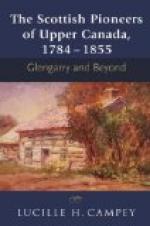The Hurons of this period painted their faces black and red, mixing the colours with oil made from sunflower seed, or with bears’ fat. The hair was carefully combed and oiled, and sometimes dyed a reddish colour; it might be worn long or short, or only on one side of the head. The women usually dressed theirs in one long plait. Sometimes it was done up into a knot at the back of the head, bound with eelskin. The men were usually dressed in deerskin breeches, with gaiters of soft leather. The shoes ("Moccasins”) were made of the skin of deer, bears, or beavers. In addition to this the men in cold weather wore a great cloak. The edges of these cloaks would often be decorated with bands of brown and red colour alternating with strips of a whitish-blue, and ornamented with bands of porcupine quills. These, which were originally white or grey in colour, had been previously dyed a fine scarlet with colouring matter from the root of the bed-straw (Galium tinctorum). The women were loaded with necklaces of violet or white shell beads, bracelets, ear-rings, and great strings of beads falling below the waist. Sometimes they would have plates of leather studded with shell beads and hanging over the back.
[Illustration: SAMUEL DE CHAMPLAIN; ALEXANDER HENRY THE ELDER]
In 1616 Champlain returned to France, but visited Quebec in 1617 and 1618. During the years spent at Quebec, which followed his explorations of 1616, he was greatly impeded in his work of consolidating Canada as a French colony by the religious strife between the Catholics and Huguenots, and the narrow-minded greed of the Chartered company of fur-trading merchants for whom he worked. But in 1620 he came back to Canada as Lieutenant-Governor (bringing his wife with him), and after attending to the settlement of a violent commercial dispute between fur-trading companies he tried to compose the quarrel between the Iroquois and the Algonkins, and brought about a truce which lasted till 1627.
In 1628 came the first English attack on Canada. A French fleet was defeated and captured in the Gulf of St. Lawrence, and in the following year Champlain, having been obliged to surrender Quebec (he had only sixteen soldiers as a garrison, owing to lack of food), voyaged to England more or less as a prisoner of state in the summer of 1629. He found, on arriving there, that the cession of Quebec was null and void, peace having been concluded between Britain and France two months before the cession. Charles I remained true to his compact with Louis XIII, and Quebec and Nova Scotia were restored to French keeping. In 1633 Champlain returned to Canada as Governor, bringing with him a considerable number of French colonists. It is from 1633 that the real French colonization of Canada begins: hitherto there had been only one family of settlers in the fixed sense of the word; the other Frenchmen were fur traders, soldiers, and missionaries. But Champlain only lived two years after his triumphant return, and died at Quebec on Christmas Day, 1635.




